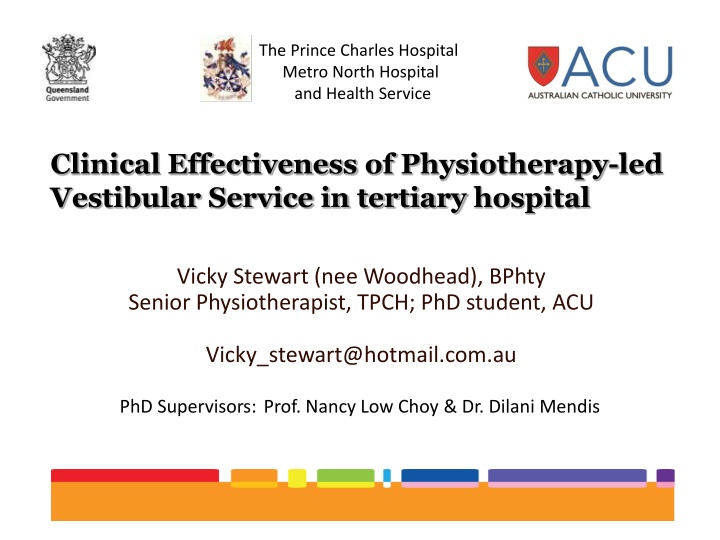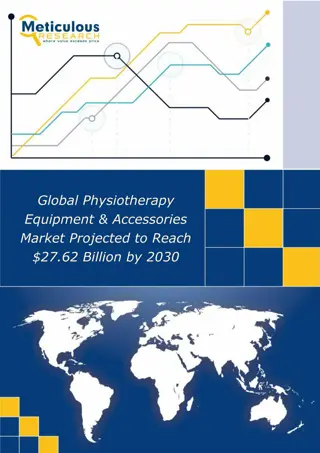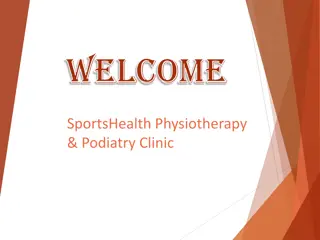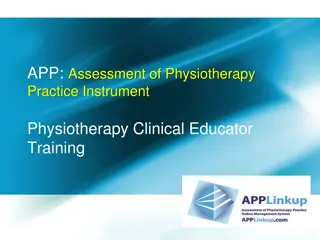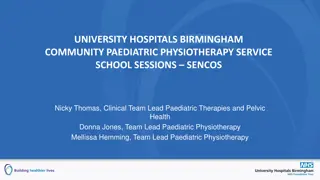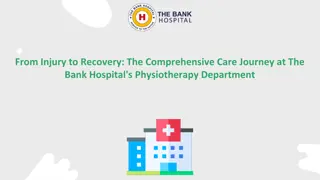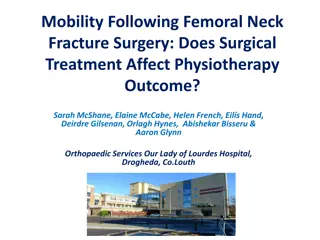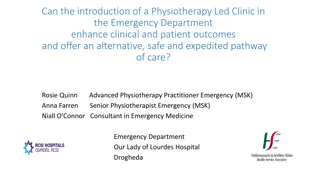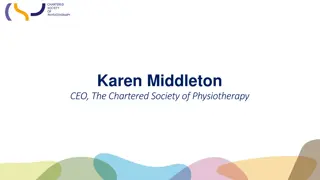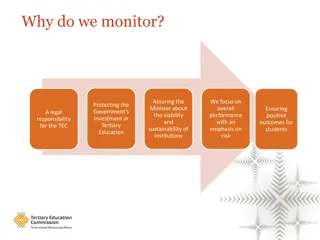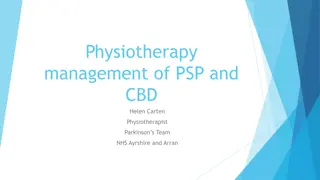Clinical Effectiveness of Physiotherapy-led Vestibular Service at Tertiary Hospital
Dizziness and vertigo are common reasons for Emergency Department visits, yet vestibular disorders are not optimally managed, leading to various negative outcomes. This study aims to investigate the clinical effectiveness of a physiotherapy-led vestibular service by assessing initial and longer-term outcomes and comparing different intervention pathways.
Download Presentation

Please find below an Image/Link to download the presentation.
The content on the website is provided AS IS for your information and personal use only. It may not be sold, licensed, or shared on other websites without obtaining consent from the author.If you encounter any issues during the download, it is possible that the publisher has removed the file from their server.
You are allowed to download the files provided on this website for personal or commercial use, subject to the condition that they are used lawfully. All files are the property of their respective owners.
The content on the website is provided AS IS for your information and personal use only. It may not be sold, licensed, or shared on other websites without obtaining consent from the author.
E N D
Presentation Transcript
The Prince Charles Hospital Metro North Hospital and Health Service Clinical Effectiveness of Physiotherapy-led Vestibular Service in tertiary hospital Vicky Stewart (nee Woodhead), BPhty Senior Physiotherapist, TPCH; PhD student, ACU Vicky_stewart@hotmail.com.au PhD Supervisors: Prof. Nancy Low Choy & Dr. Dilani Mendis
Why look at clinical effectiveness? Dizziness/ Vertigo are common reasons for ED presentations (Kroenke & Hoffman, 2000) Vestibular Disorders in Emergency Department (ED): not optimally managed (Newman-Toker, 2009) Referral to Physiotherapy Vestibular Rehab from ED: not routine practice (to assess and manage vestibular disorders) (Polsenek, 2008) Vestibular disorders not managed optimally may cause: Ongoing symptoms of dizziness/ vertigo (Herdman, 2000) Medical consultations/ referrals, re-presentation to hospital Medication use (Buchman, 2010) Interference with daily activities (Whitney, 2000) Loss of balance, falls and fall related injuries (Hall, 2004) increased healthcare costs (Lo & Harada, 2013)
Current Vestibular Service 350 No. of referrals for outpatient vestibular- physio 300 No. of referrals 250 200 150 100 50 0 2009 2010 2011 2012 2013 2014 2015 1 FTE Vestibular Physiotherapist - 0.4 FTE permanent since Jan 2014 - 0.6 temporary since Jan 2015 (Awaiting business case) Receive referrals from MOs in ED / wards (630 bed hospital) - Assess patients whilst in ED/ wards - Run daily out-patient Vestibular Rehab Physiotherapy Clinics
Vestibular Rehabilitation (VR) VR incorporates: Physical manoeuvres to remove particles from the canals (BPPV) (Bhattachayya, 2008) Education of the patient (Herdman, 2000) Exercise regimes that aim to maximise vestibular adaptation, thus reducing vertigo, dizziness and nausea (McDonnell, 2015) Habituate patients to motion sensitivity (Clendaniel, 2010) Improve balance and gait (Hillier & McDonnell, 2011) Introduce substitution strategies as required (Herdman, 2000)
Aims of the Study To investigate clinical effectiveness of a physiotherapy-led, hospital- based vestibular service by: 1. Determining initial and longer-term outcomes 2. Comparing immediate & delayed intervention pathways.
Methods of study Design: Prospective, observational study, reporting baseline, discharge and follow-up outcomes Settings: Emergency/ acute hospital setting/ hospital-based vestibular clinic Participants: Adults presenting to hospital with non-emergent dizziness Exclusion criteria: - Known cardiac/ stroke diagnosed; - Unable to provide informed consent (intoxication, mental disability, language barrier); - Fracture/ injury limiting assessment
Methods Patients presenting to hospital with non-emergent dizziness, screened (VST) & referred to Physio Vestibular Service Aim 1: Determine clinical effectiveness of Physio-led, hospital based vestibular service Physiotherapy Assessment & VR Treatment Discharge Assessment completed Short term effectiveness? 3/12 Follow-up Assessment completed Longer term effectiveness?
Methods Patient presenting to hospital with non-emergent dizziness, screened (VST) & referred to Physio Vestibular Service Determined by availability and timing of the referral Immediate Intervention pathway - Treatment commenced whilst in hospital / immediate post- discharge period (48 hours) Delayed Intervention Pathway - Discharged home from hospital - Placed on wait-list for vestibular assessment & management Aim 2: Determine clinical outcomes for immediate & delayed referral pathways Follow-up Physiotherapy Treatment Discharged: assessment completed 3/12 Follow-up assessment completed
Clinical diagnostic tests on Initial Assessment Video Frenzel and Video HIT utilized for assessment Comprehensive subjective examination Nystagmus: Spontaneous, Gaze-evoked Smooth Pursuit and Saccadic Eye Movement Test of Skew Deviation VOR Cancellation Test Head Impulse Test (HIT) Head-Shaking Nystagmus (HSN) Positional Tests including Hallpike-Dix and Head Roll Test Pressure/ Fistula testing when indicated DVA static vs. dynamic Vestibular diagnostic clinical tests used to categorise patients: Vestibular impairment Non-vestibular impairment
Vestibular Disorder Diagnosis Test Diagnosis Positive Hallpike Dix, Head Roll Test (Bhattachayya, 2008) BPPV Positive head impulse test / video head impulse test + Acute vestibular crisis history (nil central features) (Luxon, 2007) Acute vestibular neuritis, unilateral/ bilateral vestibular hypofunction Episodic symptoms of fluctuant hearing loss, vertigo, tinnitus or ear blockage confirmed by a specialist (Luxon, 2007) Meniere s Disease Migraine headaches as per international headache criteria and vestibular symptoms of imbalance, vertigo/ dizziness/ unsteadiness (Lempert, 2013) Migraine Vertigo Direction-changing gaze-evoked nystagmus or pure down-beating/ up-beating/ torsional nystagmus (Herdman, 2000) Indicative of central pathology If unclear and symptoms of vestibular dysfunction presented, the patient was categorised as other vestibular and referred for further specialist assessment
Outcome Measures Initial/ Discharge/ Follow-up assessment Subjective improvement in dizziness (McDonnell, 2015) - Patient report improved/ same/ worse Vestibular Screening Tool (VST) (Stewart, 2015) Scores of 4/8 indicate vestibular disorder Demonstrates concurrent validity with DHI 2 point change demonstrates clinically meaningful change Dizziness Handicap Inventory (DHI) (Jacobson, 1990) Scores >60 = severe vestibular dysfunction, greater functional impairment (Whitney, 2004) Functional Gait Assessment (FGA) (Wrisley, 2004; Wrisley, 2010) 22/30 predict prospective older fallers Activities Balance Confidence Scale Short form (Schepens, 2010) - Balance confidence measure 0-100%.
Results - Demographics Characteristics Total Group (n=193) Immediate Intervention (n=112) Delayed Intervention (n=81) 64 15 (19 94) 63 16 (30 94) 65 14 (19 91) Mean age SD (y) 115 (59.6) 63 (56.3) 52 (64.2) Female, n (%) 57 (29.5) 28 (25.5) 29 (36.7) Falls past 12-months, n (%) 152 (78.8) 77 (77.8) 75 (93.8) Independent Gait, n (%) Non-vestibular, n (%) 37 (19.2) 22 (19.6) 15 (18.5) Vestibular, n (%) 156 (80.8) 90 (80.4) 66 (81.5)
Clinical Vestibular Diagnosis BPPV? (42.5%)? Ves bular? neuri s(14.5%)? Unilateral? hypofunc on? (6.7%)? Unspecified? ves bular? (6.7%)? Migraine? ver go? (3.6%)? Central? (2.1%)? Bilateral? hypofunc on? (1.6%)? Meniere s? Disease? (1.6%)? Mo on? sensi vity? (1.6%)?
Intervention Groups Clinical Vestibular Diagnosis Mo on? sensi vity? Meniere s? Disease? Bilateral? hypofunc on? Central? Migraine? ver go? Delayed? Interven on? Unspecified? ves bular? Immediate? Interven on? Unilateral? hypofunc on? Ves bular? neuri s? BPPV? ? 0? 5? 10? 15? 20? 25? 30? 35? 40? 45? 50? Number?
Results Total Group (n=193) Immediate (n=112) Delayed (n=81) Diagnosed as vestibular 156 (80.8%) 90 (80.3%) 66 (81.5%) Completed discharge Ax 105 (67.3%) 67 (74.4%) 38 (57.6%) Completed Follow-up Ax 73 (69.5%) 44 (65.7%) 29 (76.3%) Immediate and delayed groups completed similar No. of Physiotherapy sessions: 3.24 3.28 Immediate group assessed within 48hrs of presenting to hospital Delayed group waited an average 22 days (3-77 days) for initial Ax
Subjective Improvement Discharge 97.8 97.1 100 90 80 Percentage 70 60 50 Immediate group 40 30 Delayed group 20 No significant difference in subjective rating scale between immediate and delayed groups (p>.05) 2.9 2.2 10 0 Improved since Initial No change/ Worse since initial 3/12 Follow-up 100 91.4 83.6 90 80 Percentage 70 60 50 Immediate group 40 30 Delayed group 16.4 20 8.6 10 0 Improved/ same since discharge Worse since discharge
Vestibular Screening Tool (VST) 8 7 *** 6 Immediate Group VST Score 5 Delayed Group 4 3 2 1 0 Initial Discharge Follow-up Significant difference between immediate and delayed group on initial Ax
Vestibular Screening Tool (VST) 8 7 *** Immediate Group 6 Delayed Group 5 VST score 4 3 2 1 0 Initial Discharge Follow-up Significant difference between immediate and delayed group on initial Ax Both groups scores were abnormal (ie. 4/8) on initial Ax
Vestibular Screening Tool (VST) *** 8 *** 7 *** Immediate Group 6 Delayed Group 5 VST score 4 3 2 1 0 Initial Discharge Follow-up Significant difference between immediate and delayed group on initial Ax Both groups scores were abnormal (ie. 4/8) on initial Ax Significant improvements between initial discharge, initial follow-up, for both groups
Dizziness Handicap Inventory (DHI) 100 90 Immediate Group 80 Delayed Group 70 * (.01) 60 DHI Score 50 40 30 20 10 0 Initial Discharge Follow-up Mild significant difference between immediate and delayed groups on initial assessment
Dizziness Handicap Inventory (DHI) 100 90 80 Immediate Group 70 Delayed Group * (.01) 60 DHI Score 50 40 30 20 10 0 Initial Discharge Follow-up Mild significant difference between immediate and delayed groups on initial assessment Immediate and Delayed groups were approaching the severe DHI level
Dizziness Handicap Inventory (DHI) 100 90 *** Immediate Group 80 *** Delayed Group 70 * (.01) 60 DHI Score 50 40 30 20 10 0 Initial Discharge Follow-up No significant difference between immediate and delayed groups on initial assessment Immediate and Delayed groups were approaching the severe DHI level Significant improvements between initial and discharge, initial and follow- up, for both groups
Functional Gait Assessment (FGA) 30 25 *** Immediate Group 20 Delayed Group FGA score 15 10 5 0 Initial Discharge Follow-up Significant difference between immediate and delayed groups on initial assessment
Functional Gait Assessment (FGA) 30 25 *** Immediate Group 20 Delayed Group FGA score 15 10 5 0 Initial Discharge Follow-up Significant difference between immediate and delayed groups on initial assessment Both groups scored below 22/30 on initial Ax = predictive of falls
Functional Gait Assessment (FGA) *** *** 30 25 *** 20 FGA score Immediate Group 15 Delayed Group 10 5 0 Initial Discharge Follow-up Significant difference between immediate and delayed groups on initial assessment Both groups scored below 22/30 on initial Ax = predictive of falls Significant improvements between initial and discharge, initial and follow-up, for both groups
Activities Balance Confidence: Short Form 6 *** 100? *** 90? 80? * (.01) 70? ABC-6? Score? 60? Immediate? Group? 50? 40? Delayed? Group? 30? 20? 10? 0? Ini al? Discharge? Follow-up? Significant difference between groups at initial assessment Both groups scored below 60/100 on initial low balance confidence Significant improvements by discharge and folllow-up assessment
Summary People who present to hospital with a vestibular dysfunction have: Moderate - severe dizziness impairment Significant functional limitations Increased risk of falling Poor community ambulation Low balance confidence Resultant symptoms and functional impact of a vestibular disorder do not always spontaneously resolve, even 3 weeks after hospital. Physio VR intervention produced significant improvements in: Dizziness impairment Balance confidence Functional gait Results were maintained 3 months post discharge
Summary Delayed group had persistent symptoms until management commenced (> 3weeks after ED presentation) ie did not spontaneously improve Both immediate and delayed physiotherapy intervention groups responded to VR & achieved similar results by D/C Significant improvements maintained three-months after discharge A physiotherapy-led vestibular service demonstrated clinical effectiveness in Mx of dizzy patients presenting to hospital Patients presenting to hospital with a suspected vestibular disorder should be considered for referral to a physiotherapy-led vestibular service in the hospital setting.
Limitations/ further Research Limitations: Differences in patient profile in the immediate & delayed groups whilst in ED is unknown Costs to patients & healthcare service for delayed group not calculated Further Research: Psycho-social impact on patients during wait-list period requires FU Rate of falls, representations/ re-admissions to hospital requires FU Proportion referred to Audiology/ Neurology/ ENT/ Psychology for FU Longer-term (>3/12) follow-up required Burden of Care to be established
References 1. Kroenke, K., & Hoffman, R. M. (2000). How common are various causes of dizziness? A critical review. Southern Medical Journal, 93(2), 160-167. 2. Newman-Toker, D. E., Camargo, C. A., Jr., Hsieh, Y. H., Pelletier, A. J., & Edlow, J. A. (2009). Disconnect between charted vestibular diagnoses and emergency department management decisions: a cross-sectional analysis from a nationally representative sample. Academic Emergency Medicine, 16(10), 970-977. doi: 10.1111/j.1553-2712.2009.00523.x 3. Polsenek, S. H., Sterk, C. E., & usa, R. J. (2008). Screening for vestibular disorders: a study of clinicians' compliance with recommended practices. Medical Science Monitor, 14(5), 238-242. 4. Herdman, S. (2000). Vestibular Rehabilitation. Philadelphia: FA Davis Company. 5. Buchman, A. S., Shah, R. C., Leurgans, S. E., Boyle, P. A., Wilson, R. S., & Bennett, D. A. (2010). Musculoskeletal pain and incident disability in community-dwelling older adults. Arthritis Care Res (Hoboken), 62(9), 1287-1293. doi: 10.1002/acr.20200 6. Bohannon, R.W. (1997). Comfortable and maximum walking speed of adults aged 20-79 years: Reference values and determinants. Age Ageing, 26, 15-19. 7. Hall, C.D., Schubert, M.C., & Herdman, S.J. (2004). Prediction of fall risk reduction as measured by dynamic gait index in individuals with unilateral vestibular hypofunction. Otology & Neurotology, 25(5), 746-751. 8. Lo, A. X., & Harada, C. N. (2013). Geriatric dizziness: evolving diagnostic and therapeutic approaches for the emergency department. Clinical Geriatric Medicine, 29(1), 181-204. doi: 10.1016/j.cger.2012.10.004 9. Bhattacharyya, N., Baugh, R. F., Orvidas, L., Barrs, D., Bronston, L. J., Cass, S., . . . Haidari, J. (2008). Clinical practice guideline: benign paroxysmal positional vertigo. Otolaryngology Head Neck Surgery, 139(5 Suppl 4), S47-81. doi: 10.1016/j.otohns.2008.08.022
References 10. McDonnell, M. N., & Hillier, S. L. (2015). Vestibular rehabilitation for unilateral peripheral vestibular dysfunction. Cochrane Database of Systematic Reviews, 13(1). doi: 10.1002/14651858.CD005397.pub4 11. Clendaniel, R.A. (2010). The effects of habituation and gaze stability exercises in the treatment of unilateral vestibular hypofunction: a preliminary results. Journal of Neurologic Physical Therapy, 34(2), 111-116. 12. Hillier, S. L., & McDonnell, M. (2011). Vestibular rehabilitation for unilateral peripheral vestibular dysfunction. Cochrane Database Systematic Reviews(2), CD005397. doi: 10.1002/14651858.CD005397.pub3 13. Luxon, L. M., & Bamiou, D. E. (2007). Vestibular system disorders. In A. H. Schapira (Ed.), Neurology and clinical neuroscience (Vol. 1, pp. 337-353). Philadelphia: Mosby Elsevier. 14. Lempert, T. (2013a). Vestibular Migraine. Semin Neurol, 33(3), 212-218. 15. McDonnell, M. N., & Hillier, S. L. (2015). Vestibular rehabilitation for unilateral peripheral vestibular dysfunction. Cochrane Database of Systematic Reviews, 13(1). doi: 10.1002/14651858.CD005397.pub4 16. Stewart, V., Mendis, M.D., Rowland, J., & Low Choy, N. (2015). Construction and Validation of the Vestibular Screening Tool for use in the Emergency Department and Acute Hospital Setting. Archives of Physical Medicine Rehabilitation, 96, 1253-1260. 17. Jacobson, G. P., & Newman, C. W. (1990). The development of the Dizziness Handicap Inventory. Archives Of Otolaryngology--Head & Neck Surgery, 116(4), 424-427. 18. Wrisley, D.M., & Kumar, N.A. (2010). Functional Gait Assessment: Concurrent, discriminative and predictive validity in community dwelling older adults. Phys Ther, 90(5), 761-773. 19. Wrisley, D.M., Marchetti, D.F., Kuharsky, D.K., & Whitney, S.W. (2004). Reliability, internal consistency, and validity of data obtained with the functional gait assessment. Phys Ther, 84, 906-918.
Acknowledgements & Funding Acknowledgements: Sue Lewandowski (Physiotherapist) Dr Jeff Rowland (Specialist) Funding: HP Research Grant ($20,000.00) QRPN Research Grant ($2,000.00)
Questions? Thank-you vicky_stewart@hotmail.com.au
Clinical Diagnosis Total (n = 193) Immediate (n = 112) Delayed (n = 81) - Non-vestibular, n (%) 37 (19.2) 22 (19.6) 15 (18.5) - Vestibular: n (%) BPPV 82 (42.5) 46 (41.1) 36 (44.4) Vestibular neuritis 28 (14.5) 20 (17.9) 8 (9.9) Unilateral hypofunction 13 (6.7) 7 (6.3) 6 (7.4) Bilateral hypofunction 3 (1.6) 3 (2.7) 0 (0.0) Migraine vertigo 7 (3.6) 3 (2.7) 4 (4.9) Meniere s Disease 3 (1.6) 2 (1.8) 1 (1.2) Central 4 (2.1) 4 (3.6) 0 (0.0) Motion sensitivity 3 (1.6) 1 (0.9) 2 (2.5) Unspecified vestibular 13 (6.7) 4 (3.6) 9 (11.1)
Results - Demographics Characteristic Total group Immediate Delayed (n = 193) Intervention (n = 112) Intervention (n = 81) Mean age SD 64 15 63 16 65 14 (y) (19 94) (30 94) (19 91) Female, n 115 63 52 (%) (59.6) (56.3) (64.2) Falls past 12 months, n 57 28 29 (%) (29.5) (25.5) (36.7) Independent gait, n 152 77 75 (%) (78.8) (77.8) (93.8)
VST: Vestibular Screening Tool (Stewart et al, 2015) Stewart, V., Mendis, M.D., Rowland, J., Low Choy, N.L. (2015)Construction and Validation of the Vestibular Screening Tool for Use in the Emergency Department and Acute Hospital Setting. Archives of Physical Medicine and Rehabilitation 96 (12): 2153-60 VST is Valid & Reliable tool for use in hospital setting High Sensitivity (83%) & Specificity (84%) for identifying a likely vestibular disorder when patients present to hospital with non-emergent dizziness Uni-dimensional internal construct validity High inter-rater reliability (0.988 ICC) High intra-rater reliability (0.878 ICC)
VST Validation Results Study #1 Vestibular Disorder VST Scores 4/8: Predict vestibular dysfunction as cause to non-emergent dizziness 4/8 VST Scores 3/8: Non-vestibular cause to dizziness more likely Non-Vestibular Disorder
VST Vestibular Screening Tool Yes Sometimes No 1. Do you have a feeling that things are spinning or moving around? Yes Sometimes = 1 No = 2 2. Does bending over and/ or looking up at the sky make you feel dizzy? = 0 3. Does lying down and/ or turning over in bed make you feel dizzy? TOTAL / 8 4. Does moving your head quickly from side to side make you feel dizzy?
Statistics Means / SD outcome measures determined for initial, discharge & follow-up assessment Linear mixed Models Determined significance of the mean difference of measures across continuum of care Compared differences in mean scores between immediate & delayed intervention groups
